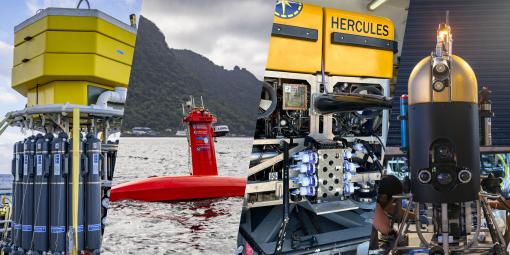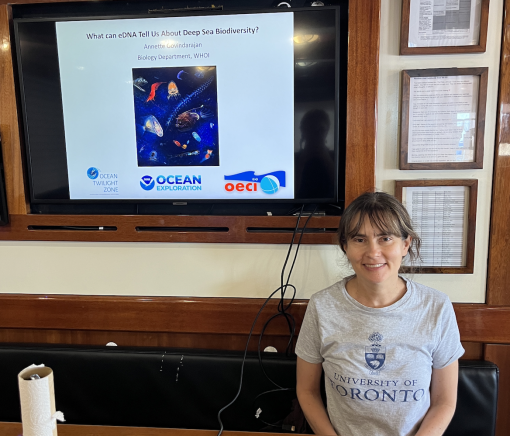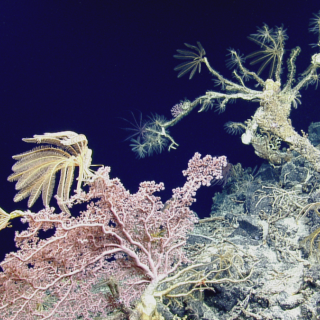Exploring Life at Vailuluʻu with Cutting-Edge Ocean Science Technologies

This blog was written by NA165 Communications Lead and OET Media and Outreach Coordinator Jamie Zaccaria.
One of the most exciting scientific themes spanning both E Mamana Ou Gataifale expeditions in American Samoa is the study of biodiversity at Vailuluʻu Seamount using several new ocean exploration technologies. Vailuluʻu provides a unique ecological setting as it is the only active volcano in the Samoan archipelago. Scientists know that seamounts, in general, are biodiversity hotspots (due to the upwelling of currents that bring nutrients to surface waters), but studying Vailuluʻu will help us understand how the volcanic activity of this seamount impacts both water column and seafloor biodiversity by fueling deep sea biological productivity at hydrothermal vents.
Sunlight does not penetrate the deep sea, so deep sea animals typically rely on organic material originating in the surface waters for sustenance. However, hydrothermal vent fluids release chemicals that can be used as a source of energy for some microbial life in lieu of sunlight. Woods Hole Oceanographic Institution (WHOI) Biologist Dr. Annette Govindarajan is seeking to find out how these “chemosynthetic” communities at Vailulu’u might augment biodiversity even more than what is found on other hydrothermally inactive seamounts in the area. Towards that end, Annette and her colleagues are collecting samples at Vailulu’u, as well as other seamount sites and abyssal plains that lack seamounts.
Annette is especially interested in studying the biodiversity associated with diel vertical migration (DVM) - the phenomenon where animals migrate to the surface at night and back to the depths during the day. Many types of zooplankton and fish participate in this mass movement, motivated by the need to access food and escape predators. Scientists know this process is important for accelerating carbon transfer to the deep sea. Annette and her colleagues want to know if this process is enhanced or altered by the volcanic activity at Vailuluʻu.
“The typical DVM pattern isn’t always followed; some species don’t migrate, and sometimes species migrate in the opposite direction coming to the deep waters during the night and the surface during the day,” says Annette Govindarajan. “There’s a lot of variation to the DVM typical model, and now we’re in a unique setting with a food source in the deeper water from the hydrothermal vents, so we want to see what this area’s DVM pattern will look like.”
Anecdotally, there are observations of whale and other top predator activity in surface waters above Vailuluʻu, including hydrophone recordings of whales from the University of Rhode Island’s Graduate School of Oceanography’s Deep Autonomous Profiler (DAP) Lander during NA164. While diving in the midwater, WHOI's Mesobot provided imagery of zooplankton and other marine animals (even large sharks). This might support the hypothesis of enhanced production in these waters due to volcanic activity.
Using what we learned with the Center for Coastal and Ocean Mapping/Joint Hydrographic Center’s USV Drix, WHOI’s Mesobot, and URI GSO’s DAP Lander in NA164, we’re targeting ROV Hercules and WHOI’s AUV Sentry sampling in NA165 to specific areas. By sampling at Vailuluʻu and other sites, we can compare these water column processes such as DVM and speculate on how they may be influenced by volcanic activity.

To address these scientific goals, Annette and her colleagues are sampling for something called environmental DNA (eDNA). In animals, eDNA is composed of small pieces of organismal fragments containing DNA found within the environment, including shed skin cells, mucus, feces, or small pieces of tissue. eDNA can show various organisms that live or pass through an area, even if they are not observed on camera in front of the ROVs during a dive. This is especially useful when studying animals difficult to sample because they’re too small, too fast, or too fragile.
“One of the really exciting things about using eDNA is that it’s the one sampling method where you can sample all domains of life with a single sample. We can look for microorganisms, zooplankton, fish, and even whales all at once. You can’t do something like that with a net,” Govindarajan says.
An exciting tool that we are using on both NA164 and NA165 is large-volume eDNA samplers. These samplers filter seawater in situ, so they can collect much more water than the standard sampling bottles, which is important in the deep sea where eDNA signals are diluted. Also by filtering the water in situ, we don’t need to spend long hours in the lab doing it manually, where we are also exposed to potential contamination sources.

Annette has been deploying samplers, developed collaboratively by Oceanic Labs and WHOI, on the midwater robot Mesobot and other platforms for a few years now, but these samplers have been limited to use at depths of 1,000 meters or less. On NA165, a new sampler that can go even deeper called the Multipuffer, produced by Aquatic Labs, is being deployed on the ROV Hercules. Previously, eDNA collection on the ROV has been limited to six Niskin bottles, so the addition of the Multipuffer greatly increases its eDNA sampling potential.
Sampling with ROV Hercules is focused near the seafloor, so it's complementary to Mesobot’s water column sampling. ROV Hercules also allows us to target areas near deep sea corals and other places of high benthic diversity. And we do it all from inside the control van, thanks to software interfaces that let us have remote control.
“What's really unique is that we’re using both cruises to examine a science problem with a host of different tools, adding more context and data to the study than we could have done with a typical expedition,” says Govindarajan. “During NA164, we had Mesobot in the midwater, the DAP Lander on the seafloor, and DriX on the surface to lead adaptive sampling targeting migrating layers by telling Mesobot where to go. Now on NA165, with Hercules, we can sample in a fourth way using long dive transects of the seafloor in places we’re usually unable to get to.”

Using high-volume samples on different platforms allows us to take advantage of each vehicle's attributes and combine them into a more complete picture of biodiversity in a unique and compelling scientific setting. The work done on NA164—and continuing on NA165—is a culmination of the past few years of OECI technology collaboration. By continuing to develop and test these tools, we’re learning more about the deep ocean than ever before.
“It’s tremendous to see large volume samplers, originally designed for Mesobot, be integrated with other vehicle systems. It expands the types of samples we collect and the scientific questions we can address. In the future, I would anticipate that this is a tool used across the ocean exploration and science community,” said OECI Director Adam Soule.
The NA165 expedition is funded by NOAA Ocean Exploration, NOAA Office of Marine and Aviation Operations Uncrewed Systems Operations Center, and the Bureau of Ocean Energy Management via the Ocean Exploration Cooperative Institute (OECI) with additional support from Woods Hole Oceanographic Institution (WHOI), Air/Sea Heritage Foundation, and other partners. The NA164 expedition was funded by NOAA Ocean Exploration via the Ocean Exploration Cooperative Institute.

E Mamana Ou Gataifale II - American Samoa
American Samoa is the southernmost U.S. territory, centered in the South Pacific, 2,300 miles southwest of Hawaiʻi, and 1,500 miles northeast of New Zealand. It is home to the cradle of Polynesia’s oldest culture.



